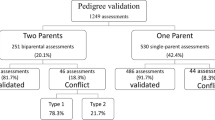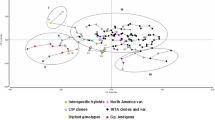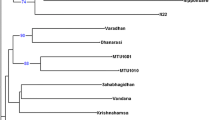Abstract
A study was performed to determine how bioinformatics algorithms could be employed to classify and estimate 50 potato commercial and wild populations using microsatellite (SSR) markers. In this study, 40 SSR primers were used for estimating the genetic structure of all 50 potato populations. The data were generated in two different experiments including 32 wild and 18 commercial accessions. The results indicate that 31 SSR primers were polymorphic, and also these primers with 334 alleles were analyzed. Analyses through data cleaning, attribute weighting, and machine learning classified the populations into different categories. The machine learning methods used here for classifying the potato accessions discovered that the SS110 was the best SSR primer for the potato population analysis, and also, it can be emphasized that the machine learning analyses are the best tool for the classification of potato populations based on populations specific genetic architecture.




Similar content being viewed by others
References
Beiki AH, Saboor S, Ebrahimi M (2012) A new avenue for classification and prediction of olive cultivars using supervised and unsupervised algorithms. PLoS ONE 7:e44164
Björn B, Keizer PL, Paulo MJ, Visser RG, van Eeuwijk FA, van Eck HJ (2014) Identification of agronomically important QTL in tetraploid potato cultivars using a marker-trait association analysis. Theor Appl Genet 127:731–748
Boz Y et al (2011) Genetic characterization of grape (Vitis vinifera L.) germplasm from Southeast Anatolia by SSR markers. Vitis 50:99–106
Cipriani G, Marrazzo MT, Peterlunger E (2010) Molecular characterization of the autochthonous grape cultivars of the region Friuli Venezia Giulia—North-Eastern Italy. Vitis 49:29–38
Côté M-J, Leduc L, Reid A (2013) Evaluation of simple sequence repeat (SSR) markers established in Europe as a method for the identification of potato varieties grown in Canada. Am J Potato Res 90:340–350
Doulati-Baneh H, Mohammadi S, Labra M (2013) Genetic structure and diversity analysis in Vitis vinifera L. cultivars from Iran using SSR markers. Sci Hortic 160:29–36
Ebrahimi M et al (2014) Understanding the underlying mechanism of HA-subtyping in the level of physic-chemical characteristics of protein. PLoS ONE 9:e96984
Guinand B, Topchy A, Page K, Burnham-Curtis M, Punch W, Scribner K (2002) Comparisons of likelihood and machine learning methods of individual classification. J Hered 93:260–269
Guyon I, Elisseeff A (2003) An introduction to variable and feature selection. J Mach Learn Res 3:1157–1182
Huang H, Lu J, Ren Z, Hunter W, Dowd SE, Dang P (2011) Mining and validating grape (Vitis L.) ESTs to develop EST-SSR markers for genotyping and mapping. Mol Breed 28:241–254
Machida-Hirano R (2015) Diversity of potato genetic resources. J Breed Sci 65:26–40
Martín L, de Miera LES, Martín MT (2014) AFLP and RAPD characterization of Phaeoacremonium aleophilum associated with Vitis vinifera decline in Spain. J Phytopathol 162:245–257
Mohammadzadeh Jalaly H, Valizadeh M, Ahmadi M, Nabizadeh H, Moharramnejad S, Moghaddam M (2015) Discrimination of alfalfa half-sib families by allozyme banding pattern and its relationship with forage yield attributes. J Biodivers Environ Sci 6:344–350
Nookaraju A, Agrawal D (2012) Genetic homogeneity of in vitro raised plants of grapevine cv. Crimson seedless revealed by ISSR and microsatellite markers. South Afr J Bot 78:302–306
Tarca AL, Carey VJ, Chen X-w, Romero R, Drăghici S (2007) Machine learning and its applications to biology. PLoS Comput Biol 3:e116
Torabi-Giglou M, Jaber P, Mohammadi SA, Nahandi FZ, Azar AM, Śliwka J (2015) DNA, and morphological diversity and relationship analysis of selected cultivated, wild potatoes and some promising hybrids. J Biodivers Environ Sci (JBES) 6:175–186
Torkzaban B et al (2015) Machine learning based classification of microsatellite variation: an effective approach for phylogeographic characterization of olive populations. PLoS ONE 10:e0143465
Wang Y, Zhang Y, Fang J, Liu C, Song C-N, Sun X (2012) Rapid identification of 72 grape cultivars by using RAPD markers-based MCID method. Sci Agric Sin 45:2913–2922
Author information
Authors and Affiliations
Contributions
MTG performed and designed the experiments; SM wrote the article and analyzed the data. JP and AE designed the experiments. EG helped to analyze the data.
Corresponding author
Ethics declarations
Conflict of interest
The authors declare that there is no conflict of interest.
Rights and permissions
About this article
Cite this article
Torabi-Giglou, M., Moharramnejad, S., Panahandeh, J. et al. Machine Learning for Detecting Potato Populations Using SSR Markers. Iran J Sci Technol Trans Sci 44, 911–918 (2020). https://doi.org/10.1007/s40995-020-00896-2
Received:
Accepted:
Published:
Issue Date:
DOI: https://doi.org/10.1007/s40995-020-00896-2




